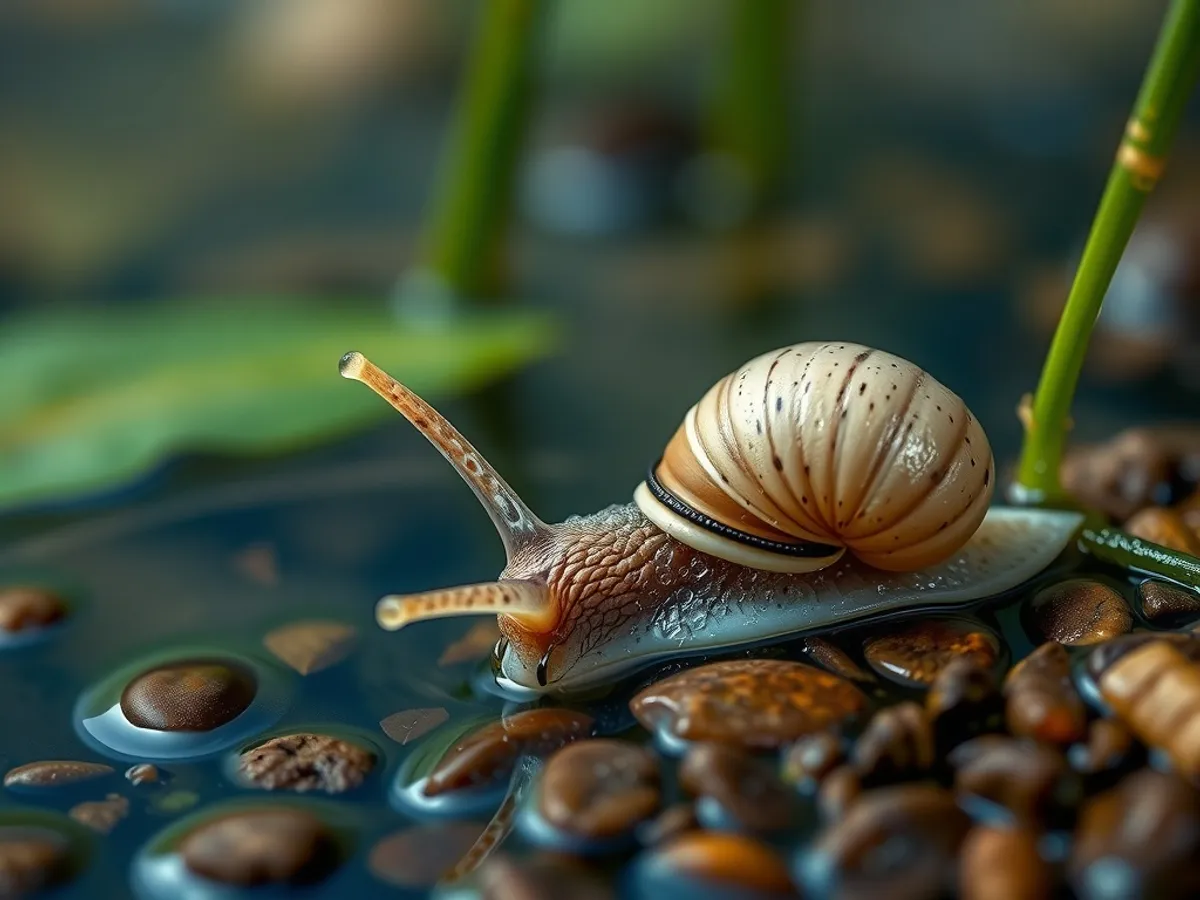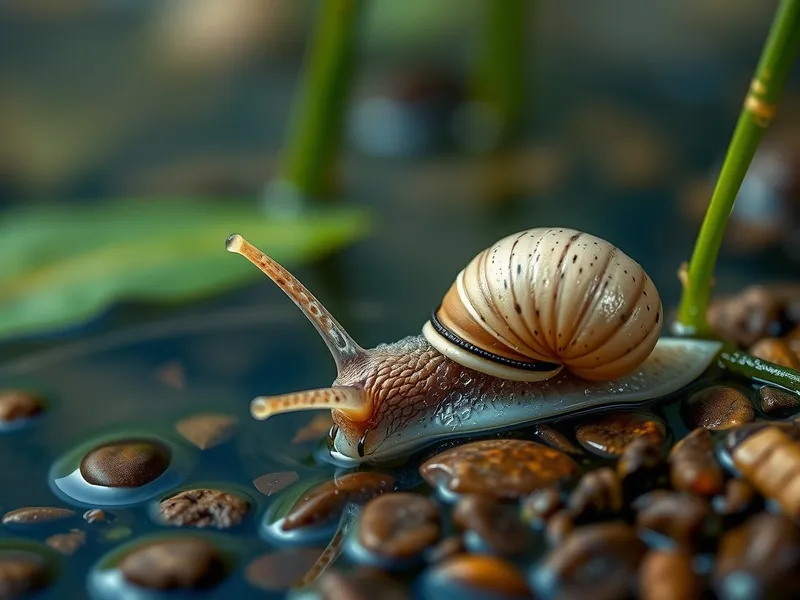
Ramshorn Snail
Planorbella duryi

Meet the Ramshorn Snail
The Ramshorn Snail is a small freshwater snail known for its distinctive, planispiral shell that resembles the shape of a ram’s horn. These snails are commonly found in aquariums and natural freshwater habitats, where they play a vital role in controlling algae and cleaning up detritus. Ramshorn snails are highly adaptable and can thrive in various water conditions, making them popular among aquarium enthusiasts. Their shells come in a variety of colors, including brown, red, and even blue, and they reproduce prolifically under favorable conditions.
Classification
Invertebrate
Habitat
Freshwater
Diet
Herbivore
Lifespan
1-2 years
Conservation
Least Concern
Weight
0.1-1 gram
📖Fascinating Facts
Unique Shell Shape
The Ramshorn Snail's shell coils in a flat, circular spiral, resembling the horn of a ram, which is where it gets its name.
Efficient Cleaners
These snails help keep aquariums clean by feeding on algae, decaying plants, and leftover fish food.
Hermaphroditic Reproduction
Ramshorn snails are hermaphrodites, meaning each individual possesses both male and female reproductive organs, allowing for rapid population growth.
📋Detailed Description
Planorbella duryi, commonly known as the Ramshorn Snail, is a medium-sized freshwater gastropod mollusk belonging to the family Planorbidae. Adults typically reach shell diameters of 15–25 mm, with a flat, planispiral shell that coils in a single plane, giving it the characteristic ram’s horn appearance. The shell is thin, fragile, and varies in color from brown and reddish to rare blue morphs, often influenced by genetic factors and environmental conditions. The soft body is usually a translucent gray or reddish hue, with two long tentacles and a muscular foot adapted for gliding along submerged surfaces. Ramshorn snails possess a highly vascularized mantle cavity, functioning as a lung, allowing them to breathe atmospheric air at the water’s surface—a key adaptation for surviving in low-oxygen environments. They are primarily nocturnal, spending daylight hours concealed under debris or vegetation. Their radula, a ribbon-like structure with rows of microscopic teeth, is specialized for scraping algae, biofilm, and decaying plant matter from surfaces. Ramshorn snails are hermaphroditic, with each individual possessing both male and female reproductive organs, enabling self-fertilization or cross-fertilization with conspecifics. Their prolific reproductive capacity, rapid maturation, and tolerance for a wide range of water conditions contribute to their success in both natural and artificial habitats.
💡 Did you know?
Some aquarium hobbyists use Ramshorn Snails as natural indicators of water quality, as their population booms may signal excess nutrients or algae in the tank.
🔬Research & Sources
🎭Behavior & Social Structure
Ramshorn snails are generally solitary but may aggregate in areas with abundant food. They exhibit slow, deliberate movements, using their muscular foot to glide along submerged surfaces. Feeding occurs primarily at night or in low light, when they emerge to graze on algae, biofilm, and detritus. They are opportunistic feeders, sometimes consuming soft aquatic plants if other food sources are scarce. Ramshorn snails are known for their ability to float by trapping air in their mantle cavity, which can aid in dispersal or escape from predators. They are sensitive to water quality and will migrate vertically in the water column to access optimal oxygen levels. Social interactions are limited, but during mating, individuals may engage in reciprocal copulation. They exhibit thigmotactic behavior, preferring to remain in contact with surfaces, and will retreat into their shells when threatened.
👶Reproduction & Life Cycle
Planorbella duryi is a simultaneous hermaphrodite, meaning each individual possesses both male and female reproductive organs. Mating usually involves reciprocal copulation, where two snails exchange sperm, but self-fertilization is also possible, especially in isolated individuals. After mating, eggs are laid in gelatinous clusters on submerged surfaces such as plant leaves, rocks, or aquarium glass. Each clutch contains 12–40 eggs, and a single snail can lay multiple clutches per week under optimal conditions. Embryonic development is direct, with no larval stage; juveniles hatch fully formed after 7–14 days, depending on water temperature (optimal range: 22–28°C). There is no parental care post-oviposition. Sexual maturity is reached rapidly, often within 4–6 weeks, contributing to their reputation for rapid population growth in favorable environments.
🛡️Adaptations & Survival
Ramshorn snails exhibit several adaptations for survival in fluctuating freshwater habitats. Their lung-like mantle cavity allows them to breathe atmospheric air, enabling survival in oxygen-poor waters. The planispiral shell provides a low center of gravity and facilitates movement in dense aquatic vegetation. Their radula is highly effective for scraping a wide variety of food sources, including tough algal films. The ability to self-fertilize ensures reproductive success even in low-density populations. Their gelatinous egg masses protect developing embryos from desiccation and some predators. Additionally, their tolerance for a broad range of water parameters (pH 6.0–8.0, hardness 5–20 dGH) and resistance to moderate pollution make them highly adaptable and resilient.
📚Research Sources
🎨Cultural Significance
Ramshorn snails have long been popular in the aquarium trade, valued for their algae-eating abilities and ornamental shell colors. They are sometimes used in educational settings to demonstrate gastropod anatomy and reproductive strategies. In some cultures, snails in general are associated with patience and resilience, though Planorbella duryi does not have significant mythological or symbolic roles. There are no known traditional medicinal or culinary uses for this species. Their presence in aquaria has also led to their use as bioindicators of water quality.
🔬Recent Research & Discoveries
Recent research has focused on the role of Planorbella duryi in freshwater ecosystems, particularly their influence on algal dynamics and nutrient cycling. Studies have examined their capacity to serve as intermediate hosts for trematode parasites, with implications for fish and human health. Genetic analyses have explored population structure and the basis of shell color polymorphism. Ongoing research investigates their potential as model organisms for studying hermaphroditism, rapid adaptation, and the impacts of invasive species. Their resilience to environmental stressors makes them useful in ecotoxicological studies, particularly for assessing the effects of heavy metals and pesticides on aquatic invertebrates.
🎥Wildlife Videos

We go beneath the surface of our wildlife pond. Such a strange world ... come see
In this video I use a waterproof camera to delve beneath the surface of our wildlife pond. It's a world we rarely see and cannot ...
The Cottage Wildlife Garden

Snails | Snail Animal Facts | The Wonderful World of Invertebrates
Snails are called a huge variety of diverse gastropod molluscs that have an outer shell. These include not only land snails, but ...
Primeval Old Man

Snail Facts You Probably Didn't Expect
Find out more about these Snail Facts in our article: https://facts.net/snail-facts/ Most snails are harmless creatures that crawl ...
Facts Net

Secret Life of a Snail
Please slow down. "Secret life of a snail" was fully filmed in Lochend Park, Edinburgh. Sound was recorded in Lochend Park, ...
Norbert Grabowski

All about Ramshorn Snails - Why I love these fast breeding cleaners!
Ramshorn snails seem to either be getting bad press for how quickly they breed, or being completely ignored despite the fact they ...
Tiny Menagerie

The world of the freshwater snails - Die Welt der Süßwasserschnecken
maryvandyce
🌍Habitat Information
The Ramshorn Snail typically inhabits Freshwater environments. Ramshorn Snails have adapted to their environments with specialized features and behaviors.
Primary Habitat:
Freshwater
More detailed habitat information will be available soon.
🛡️Conservation Status
The Ramshorn Snail is currently classified as Least Concern. Conservation efforts are crucial for preserving this species for future generations.
Common Threats:
- 🏠Habitat loss and fragmentation
- 🌡️Climate change impacts
- 🎯Hunting and poaching
- 🏭Human-wildlife conflict
⚠️Threats & Conservation Challenges
In their native and introduced ranges, Ramshorn snails face predation from fish, aquatic insects, and some waterfowl. They are susceptible to copper-based chemicals and some snail-eating fish in aquaria. In natural habitats, habitat destruction, water pollution, and competition with invasive species can impact local populations, though their adaptability generally buffers against severe declines. Overpopulation in closed systems (e.g., aquariums) can lead to resource depletion and increased disease transmission. Globally, Planorbella duryi is not considered threatened, and populations are stable or increasing, partly due to human-mediated dispersal. However, their introduction outside native ranges can pose ecological challenges, including competition with native gastropods and potential transmission of trematode parasites.
🔬Scientific Classification
Scientific Name
Planorbella duryi
Classification Hierarchy
🔍 About Taxonomic Classification
Taxonomic classification is a hierarchical system used by scientists to classify and organize living organisms based on shared characteristics and evolutionary relationships.
The system moves from broad categories (Kingdom) to increasingly specific ones, with each animal's scientific name typically consisting of its Genus and species.
📝Community Notes
Share your observations and insights about the Ramshorn Snail with our community of wildlife enthusiasts.
Join Our Community
Sign in to share your observations and connect with fellow wildlife enthusiasts.
Sign In to ContributeNo community notes yet
Be the first to share your observations about the Ramshorn Snail!
Explore Ramshorn Snail
Select a tab above to learn more about this amazing animal.
📸Photo Gallery
No photos available for this animal yet.
🌟Discover More Wildlife
Continue your journey of discovery with more fascinating animals from our database
